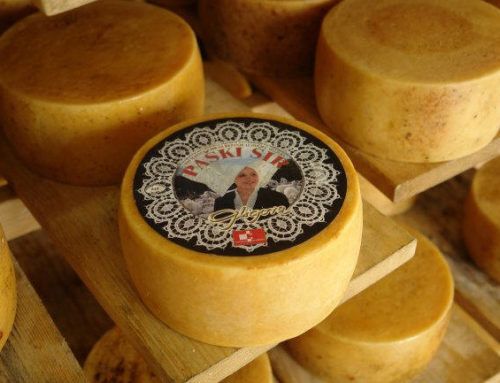Put Lard Back in Your Larder
In praise of lard and its multitude of traditional uses.

After years of experimenting with other shortenings, such as Crisco in my misinformed youth and butter in my “French phase,” I have returned to lard, because it makes the most pliable and dependably flaky crust—an ideal partner for fall fruit pies. I have come to the opinion that there is no substitute for lard when making a pie crust—not even butter for it does not impart the same “stretchable” and “flaky” qualities to the dough as lard—as I personally witnessed in Hungary.
On a recent visit to Budapest, I was treated to a special demonstration on how to make a traditional apple strudel. Two young female chefs at Owl’s Nest, owned by world-renowned restaurateur George Lang, stretched a pliant dough made from flour and lard until it was thin enough to read newspaper through, and then, after adding the filling, rolled the dough into a cylinder as long as the table. A few quick cuts made smaller rolls that would fit on a baking tray that was whisked off to the oven. This was to be my dessert. I would come to learn there is no substitute for the lard used in traditional Hungarian pastries and other fine dishes.
“During my childhood back in Hungary,” says Lang, “lard had a completely different connotation from the one in the West. Here, we accept the French credo that the three things most needed in the kitchen are butter, butter and butter. My mother ran a Kosher home and usually cooked with goose fat, so I did not enjoy dishes made with delicious Hungarian homemade lard at home. But when eating at friend’s houses and on other occasions, I filled myself with good lard-made dishes. Lard was often simply spread on a good slice of bread and then sprinkled with paprika for a snack, used in the preservation of pickles and vegetables to seal the jars, and to make splendid pastries and patés.”
The healthy, 78-year-old Lang, who lives a life between two continents, thinks that today’s characterization of lard as unhealthy, verging on damaging, is most unfortunate. To him, certain things—some most unexpected ones—simply taste better when made with lard. “Scrambled eggs fried in lard are fabulous,” he says.
In Germany, a lard/crackling combo called Grieben Schmalz is a ubiquitous appetizer. Cracklings, or grieben, are the solids left after rendering the lard. When some of the cracklings are mixed back in with the lard, this produces something the consistency of crunchy peanut butter. This humble appetizer, often served at room temperature in little stoneware pots, is spread on rye bread as an appetizer (or a buffer against intoxication) with a glass of wine before dinner. It has even made its way into some of the best restaurants, like those in the Four Seasons Hotel in Hamburg. Newcomers may be squeamish about trying this traditional German farmhouse food, but will likely become hooked on the very flavorful spread if they do.
While the Germans may have a new-found appreciation for lard—or secretly kept it all along—other cultures are battling with their stance on the fat. For example, a recent article in The New York Times featured a Mexican woman who opened a restaurant in Oaxaca and then bemoaned the fact that the locals were boycotting her establishment because she had substituted canola oil for lard in all her dishes. I side with the locals. Lard, although commonly misidentified as a saturated fat, should really be classified as a monounsaturated fat. According to Mary Enig, author of Know Your Fats, lard is about 40 percent saturated, 50 percent monounsaturated, and contains 10 percent polyunsaturated fatty acids. It is also one of our richest dietary sources of vitamin D.
Obviously, lard is making a comeback from its nadir after years of vilification by big food corporations eager to push their plastic substitutes (see “The Rise and Fall of Crisco”).
As for me, I make a sport out of hunting down good sources of lard. Since most of the lard sold in grocery stores (if you are lucky enough to find it at all) contains preservatives like BHT added to prolong its shelf life, I look for farmers who sell what they can’t use. Sometimes local butchers carry additive-free lard, or can order it for you.
| According to food science guru Harold McGee, lard’s creates stretchable and flaky pastries due to its chemistry. Lipids, like other molecules, form crystals just below their melting point. Lard is better suited for pastries because it forms crystals so large they impart a noticeably grainy texture to the dough—which produces wonderful flakiness. |
MOTHER LINDA’S PIE CRUST
Feel free to alter the type of flour, but be aware that low-gluten flours like spelt will not produce an elastic pie crust and thus be very hard to roll out. Also, the flour you choose will completely dictate the amount of water needed. Enjoy!
- 2½ cups unbleached white flour, whole wheat pastry flour
- or a combination
- 1 tsp. sea salt
- ½ cup organic lard
- ½-¾ cup cold still or sparkling water
Measure flour into a medium-sized bowl, add salt and stir. Add lard and use a pastry cutter or fork to cut the lard into pea-sized pieces until the mixture resembles a coarse meal. You can confidently add the first ½ cup of the water, but continue adding the rest ¼ cup water one tablespoon at a time until the dough starts to come together. Lightly knead with your hands to make a ball and then divide into two equal parts. Reshape into a ball and then flatten into a disc; wrap with plastic wrap and refrigerate for 30 minutes. Makes two 10-inch pie crusts.
For more information:
Black, Kent, (August 14, 2002). In Oaxaca, a Cook Creates a Stir, The New York Times, pp. D1 & D4.
Forristal, Linda Joyce, (Summer 2001). The Rise and Fall of Crisco, Wise Traditions, pp. 56-57.
Lang, George, The Cuisine of Hungary, Bonanza Books, New York, 1990.
McGee, Harold, On Food and Cooking: The Science and Lore of the Kitchen, Charles Scribner’s Sons, New York, 1984.

